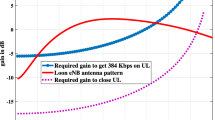Abstract
Satellite communication provides services to users over wide area. However, the propagation delay and the link budget associated with the long path make the communication difficult. Better link budget and smaller user antennas make high-altitude platform (HAP) based communication one of the favourite choice to last mile users over satellite connectivity. HAPs with overlapped service area form an interference limited system. To this end, interference alignment is proposed as promising solution to maximize capacity between multiple HAPs and ground stations. In this context, explicit expressions for system’s sum-rate and bit error rate (BER) are derived. The sum-rate and BER performance of the proposed scheme are studied for different Rician factors representing different geographical locations. Monte Carlo simulations are used to validate the analytical expressions.








Similar content being viewed by others
References
Albagory, Y., & Abbas, A. E. (2013). Smart cell design for high altitude platforms communication. AEU-International Journal of Electronics and Communications, 67(9), 780–786.
Mohammed, A., Mehmood, A., Pavlidou, F. N., & Mohorcic, M. (2011). The role of high-altitude platforms (HAPs) in the global wireless connectivity. Proceedings of the IEEE, 99(11), 1939–1953.
Mohorcic, M., Grace, D., Kandus, G., & Tozer, T. (2004). Broadband communications from aerial platform networks. In An overview of CAPANINA, IST mobile and wireless communications summit (pp. 27–30)
Grace, D., & Tozer, T. C. (2001). High-altitude platforms for wireless communications. Electronics and Communication Engineering Journal, 13(3), 127–137.
Albagory, Y., & Said, O. (2015). Performance enhancement of high-altitude platforms wireless sensor networks using concentric circular arrays. AEU-International Journal of Electronics and Communications, 69(1), 382–388.
Holis, J., & Pechac, P. (2008). Coexistence of terrestrial and HAP 3G networks during disaster scenarios. Radioengineering, 17(4), 1–7.
Yuan, C., Lin, M., Ouyang, J., & Bu, Y. (2015). Beamforming schemes for hybrid satellite-terrestrial cooperative networks. AEU-International Journal of Electronics and Communications, 69(8), 1118–1125.
Celcer, T., Javornik, T., Mohorcic, M., & Kandus, G. (2009). Virtual multiple input multiple output in multiple high-altitude platform constellations. IET Communications, 11(3), 1704–1715.
Dong, F., He, Y., Nan, H., Zhang, Z., Wang, J. (2015). System capacity analysis on constellation of interconnected HAP networks. In IEEE fifth international conference on big data and cloud computing (BDCloud) (pp. 154–159).
Grace, D., & Mohorcic, M. (2011). Broadband communications via high-altitude platforms. Hoboken: Wiley.
Liu, Y., Grace, D., & Mitchell, P. D. (2009). Exploiting platform diversity for GoS improvement for users with different high altitude platform availability. IEEE Transactions on Wireless Communications, 8(1), 196–203.
Jafar, S. A., & Shamai, S. (2008). Degrees of freedom region of the MIMO X channel. IEEE Transactions on Information Theory, 54(1), 151–170.
Cadambe, V. R., & Jafar, S. A. (2009). Interference alignment and the degrees of freedom of wireless networks. IEEE Transactions Information Theory, 55(9), 3893–3908.
Zajic, A. (2012). Mobile-to-mobile wireless channels. Norwood: Artech House.
Cadambe, V., & Jafar, S. (2008). Interference alignment and degrees of freedom of the K-user interference channel. IEEE Transactions on Information Theory, 54(8), 3425–3441.
Jafar, S. A. (2011). Interference alignment: a new look at signal dimensions in a communication network. Foundations and Trends in Communication and Information Theory, 7(1), 1–136.
Mahmoud, A., El-Khamy, M., & Elsayed, K. (2012). Interference alignment performance on MIMO X channels with imperfect channel knowledge. In Proceedings of international workshop on signal processing advances in wireless communications (pp. 239–243).
Sudheesh, P. G., Magarini, M., Muthuchidambaranathan, P. (2016) Achieving maximum system capacity in multiple-high altitude platforms through interference alignment. In Proceedings of international conference on industrial and information systems (ICIIS-2016), Roorkee.
Sudheesh, P. G., Sharma, N., Magarini, M., Muthuchidambaranathan, P. (2017). Interference alignment in multiple-high altitude platforms based communication with a generalized long distance line of sight channel model. In Proceedings of international conference on communication, management and information technology.
Torkildson, E., Madhow, U., & Rodwell, M. (2011). Indoor millimeter wave MIMO: Feasibility and performance. IEEE Transactions on Wireless Communications, 10(12), 4150–60.
Sudheesh, P. G., Mozaffari, M., Magarini, M., Saad, W., & Muthuchidambaranathan, P. (2017). Sum-rate analysis for high altitude platform (HAP) drones with tethered balloon relay. IEEE Communications Letters. https://doi.org/10.1109/LCOMM.2017.2785847.
Cho, Y. S., Kim, J., Yang, W. Y., & Kang, C. G. (2010). MIMO-OFDM wireless communications with MATLAB. Hoboken: Wiley.
Simon, M. K., & Alouini, M.-S. (2005). Digital communication over fading channels (Vol. 95). Hoboken: Wiley.
Irish, A., Quitin, F., Madhow, U., & Rodwell, M. (2013). Sidestepping the rayleigh limit for los spatial multiplexing: A distributed architecture for long-range wireless fiber. In IEEE Information Theory and Applications Workshop (ITA) (pp. 1–6).
Author information
Authors and Affiliations
Corresponding author
Rights and permissions
About this article
Cite this article
Sudheesh, P.G., Magarini, M. & Muthuchidambaranathan, P. Multiple-high altitude platforms aided system architecture for achieving maximum last mile capacity in satellite communication. Telecommun Syst 70, 27–35 (2019). https://doi.org/10.1007/s11235-018-0466-9
Published:
Issue Date:
DOI: https://doi.org/10.1007/s11235-018-0466-9




